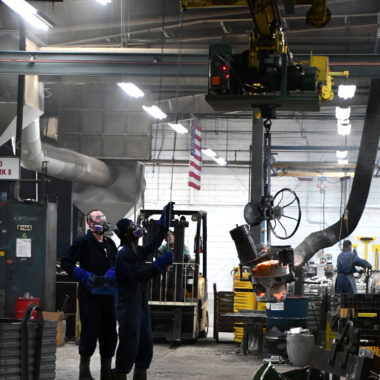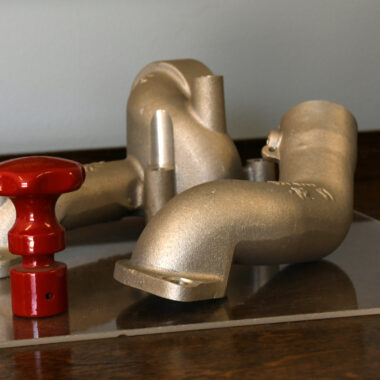Experience Superior Aluminum Casting Illinois: Your Trusted Companion
Experience Superior Aluminum Casting Illinois: Your Trusted Companion
Blog Article
Grasping the Craft: Specialist Tips for Flawless Light Weight Aluminum Spreading Results
In the realm of light weight aluminum casting, accuracy and know-how are critical to attain remarkable outcomes. Mastering the craft requires a careful understanding of the tools and equipment at one's disposal, an eager eye for preparing the light weight aluminum alloy to exact specs, and a deft hand in using optimal spreading strategies.
Important Devices and Equipment
Light weight aluminum casting requires details tools and devices to ensure precision and efficiency in the process. The crucible, normally made of graphite or ceramic products, withstands high temperature levels required to thaw light weight aluminum. The mold and mildew, frequently made of steel or sand, forms the molten light weight aluminum right into the wanted form.
Additionally, tools like tongs, handwear covers, and aprons are essential to make sure the security of drivers functioning with liquified aluminum. Tongs offer a safe and secure grip when managing hot crucibles and mold and mildews, while heat-resistant handwear covers and aprons secure versus unexpected burns. Appropriate ventilation systems are additionally crucial to eliminate fumes and guarantee a secure workplace. Purchasing premium tools and devices not just boosts the accuracy of light weight aluminum casting but likewise adds to an extra risk-free and effective manufacturing process.
Preparing the Light Weight Aluminum Alloy
To make certain the success of the light weight aluminum spreading process, careful preparation of the alloy is vital. The first action in preparing the aluminum alloy is to very carefully select the appropriate type of light weight aluminum based on the qualities needed for the end product. Elements such as toughness, deterioration resistance, and machinability require to be thought about when picking the alloy. As soon as the alloy type is determined, it is crucial to correctly clean up the aluminum to get rid of any pollutants that can impact the casting top quality. This can be done through methods like filtering, fluxing, and degassing.
After cleaning, the following vital action is to heat the light weight aluminum to the proper temperature for casting. This procedure, called alloy melting, makes sure that the aluminum is in its molten type and ready for casting (aluminum casting illinois). Furthermore, managing the temperature level throughout melting is crucial to stop overheating or underheating, which can lead to problems in the end product. On the whole, thorough preparation of the light weight aluminum alloy sets the structure for a successful spreading procedure and top quality outcome.
Ideal Casting Strategies
Carrying out accurate casting strategies is vital for accomplishing premium results in light weight aluminum casting processes. The light weight aluminum must be heated to the optimal temperature level to minimize problems like shrinking and porosity in the final cast.
Additionally, maintaining constant pouring speed and stress is vital to achieving uniformity in the cast piece. Consistent and slow putting aids protect against turbulence and air entrapment, which can result in flaws. One more important facet is using degassing representatives to eliminate pollutants and gases from the liquified light weight aluminum, causing a cleaner last item.

Achieving Smooth Surface Area Finishes
For manufacturers looking for to boost the aesthetic allure and quality of their aluminum castings, accomplishing smooth surface finishes is an essential facet following accurate casting techniques and proper cooling procedures. One secret approach to attain smooth surface finishes is by making use of high-quality molds that are properly prepared and kept. The mold surface area must be meticulously cleaned and coated with release representatives to protect against imperfections moving onto the cast light weight aluminum throughout the cooling process.
Moreover, regulating the air conditioning price of the light weight aluminum spreading is vital for achieving a smooth surface coating. Fast air conditioning can lead to thermal slopes that bring about appear flaws, while slow-moving cooling may create microstructural problems - aluminum casting illinois. By carrying out regulated cooling procedures, such as making use of air or water quenching methods, manufacturers can guarantee that the light weight aluminum solidifies consistently, decreasing the chance of surface area blemishes
Along with mold top quality and cooling down treatments, post-casting therapies like shot blasting or chemical etching can even more fine-tune the surface finish of aluminum spreadings. These methods aid smooth out any staying roughness or pollutants, causing a remarkable look that fulfills the finest criteria.
Quality Control and Troubleshooting

In the realm of troubleshooting, it is vital to have a comprehensive understanding of common issues that can take place throughout aluminum casting, such as porosity, contraction, or surface irregularities. Constant enhancement through quality control and repairing practices is basic to achieving perfect outcomes in aluminum spreading.
Verdict
In verdict, understanding the craft of light weight aluminum spreading needs crucial tools and tools, appropriate preparation of the aluminum alloy, optimum casting strategies, attaining smooth surface coatings, and implementing quality control procedures. By following these professional suggestions, perfect outcomes can be achieved in aluminum casting processes. Quality assurance and troubleshooting are very important elements to think about to guarantee consistent and top quality lead to aluminum casting tasks.
The very first step in preparing the light weight aluminum alloy is to meticulously choose the suitable type of aluminum based on the qualities required for the last product.Implementing accurate casting strategies is essential for achieving premium results in aluminum spreading procedures. By mastering these ideal casting techniques, manufacturers can regularly produce flawless aluminum castings.
For suppliers seeking to enhance the visual appeal and high quality of their aluminum castings, attaining smooth surface coatings is an important aspect adhering to exact spreading methods and proper air conditioning procedures.In final thought, grasping the craft of aluminum spreading needs vital devices and tools, appropriate prep work of the light weight aluminum alloy, optimum spreading techniques, accomplishing smooth surface finishes, and implementing high quality control measures.
Report this page